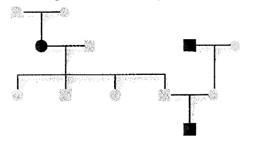
Concept explainers
Introduction:
Scientists study family history using a diagram that traces inheritance of a particular trait through several generations. Such diagrams are called pedigree. A pedigree uses symbols to illustrate the inheritance of trait. By analyzing the pedigree we can infer the genotypes by observing the
Answer to Problem 5A
Correct answer :
The correct answer is option D. Huntington’s disease
Explanation of Solution
Explanation/justification for the correct answer:
Option D. Huntington’s disease - The given pedigree illustrates inheritance of a rare genetic disorder. In this diagram, some express the disease and some do not have the disease. There are no circles or squares which are half filled; so there are no carriers of the disease. Hence we can say that the disorder is a dominant genetic disorder because a recessive genetic disorder will have a carrier. Amongst the diseases given only Huntington’s disease is a dominant genetic disease. The other three are recessive genetic disorders.

Hence this is the correct option.
Explanation for incorrect answer:
Option A. cystic fibrosis- It is a recessive genetic disorder. Since the given pedigree does not show any carrier of the disease, it may be concluded that the pedigree shows a dominant genetic disorder. Hence this is not the correct option.
Option B. albinism- It is a recessive genetic disorder. Since the given pedigree does not show any carrier of the disease, it may be concluded that the pedigree shows a dominant genetic disorder. Hence this is not the correct option.
Option C. Tay-Sachs disease- It is a recessive genetic disorder. Since the given pedigree does not show any carrier of the disease, it may be concluded that the pedigree shows a dominant genetic disorder. Hence this is not the correct option.
Chapter 11 Solutions
Biology Illinois Edition (Glencoe Science)
Additional Science Textbook Solutions
Concepts of Genetics (12th Edition)
Microbiology with Diseases by Body System (4th Edition)
Microbiology: An Introduction (13th Edition)
Microbiology: An Introduction
Human Physiology: An Integrated Approach (7th Edition)
Biology: Life on Earth (11th Edition)
 Human Anatomy & Physiology (11th Edition)BiologyISBN:9780134580999Author:Elaine N. Marieb, Katja N. HoehnPublisher:PEARSON
Human Anatomy & Physiology (11th Edition)BiologyISBN:9780134580999Author:Elaine N. Marieb, Katja N. HoehnPublisher:PEARSON Biology 2eBiologyISBN:9781947172517Author:Matthew Douglas, Jung Choi, Mary Ann ClarkPublisher:OpenStax
Biology 2eBiologyISBN:9781947172517Author:Matthew Douglas, Jung Choi, Mary Ann ClarkPublisher:OpenStax Anatomy & PhysiologyBiologyISBN:9781259398629Author:McKinley, Michael P., O'loughlin, Valerie Dean, Bidle, Theresa StouterPublisher:Mcgraw Hill Education,
Anatomy & PhysiologyBiologyISBN:9781259398629Author:McKinley, Michael P., O'loughlin, Valerie Dean, Bidle, Theresa StouterPublisher:Mcgraw Hill Education, Molecular Biology of the Cell (Sixth Edition)BiologyISBN:9780815344322Author:Bruce Alberts, Alexander D. Johnson, Julian Lewis, David Morgan, Martin Raff, Keith Roberts, Peter WalterPublisher:W. W. Norton & Company
Molecular Biology of the Cell (Sixth Edition)BiologyISBN:9780815344322Author:Bruce Alberts, Alexander D. Johnson, Julian Lewis, David Morgan, Martin Raff, Keith Roberts, Peter WalterPublisher:W. W. Norton & Company Laboratory Manual For Human Anatomy & PhysiologyBiologyISBN:9781260159363Author:Martin, Terry R., Prentice-craver, CynthiaPublisher:McGraw-Hill Publishing Co.
Laboratory Manual For Human Anatomy & PhysiologyBiologyISBN:9781260159363Author:Martin, Terry R., Prentice-craver, CynthiaPublisher:McGraw-Hill Publishing Co. Inquiry Into Life (16th Edition)BiologyISBN:9781260231700Author:Sylvia S. Mader, Michael WindelspechtPublisher:McGraw Hill Education
Inquiry Into Life (16th Edition)BiologyISBN:9781260231700Author:Sylvia S. Mader, Michael WindelspechtPublisher:McGraw Hill Education





